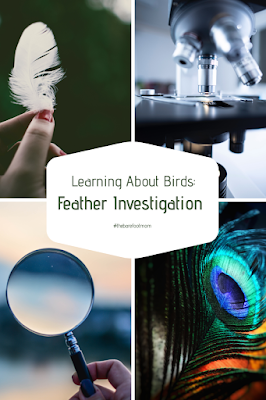All birds have feathers, and birds are the only animals on Earth that have them. Feathers play many important roles in a birds life. They provide insulation and protection from the elements, and provide camouflage to protect birds from predators. They also play a role in flight. Feathers are pretty fascinating! In this post I share some simple activities and resources for learning about feathers with your kids.
Feather Anatomy:
Feathers are made of keratin, the same protein that gives our fingernails strength. All feathers have a central shaft called a rachis. Small filaments called barbs extend off the rachis, and even smaller filaments called barbules extend off of those. Barbules have hooklets which hook the barbules together like a zipper, creating a surface capable of withstanding the pressures of flight.
Take pictures of different types of feathers you find in your yard, neighborhood, and while on nature hikes. Compare the different sizes, shapes, and colors of different feathers.
If your really ambitious, try identifying what type of bird they came from and what type of feather (flight, wing, body, or down). You can find more information about types of feathers here.
Have your child sketch what they see.
Learn about the parts of a feather and then label your feather sketch or grab the free worksheet below:
Resources and Links:
If you enjoyed this post, check out my All About Birds printable unit study and the rest of the posts in my Learning About Birds series.
Feathers are made of keratin, the same protein that gives our fingernails strength. All feathers have a central shaft called a rachis. Small filaments called barbs extend off the rachis, and even smaller filaments called barbules extend off of those. Barbules have hooklets which hook the barbules together like a zipper, creating a surface capable of withstanding the pressures of flight.
Make A Feather Photo Collection:
If your really ambitious, try identifying what type of bird they came from and what type of feather (flight, wing, body, or down). You can find more information about types of feathers here.
Sketch A Feather:
Have your child find a feather to observe or photograph and then try sketching it. Add color if you want with colored pencils or pastels.Look At A Feather Under A Microscope:
Some of the neatest parts of a feather are too small to be seen clearly with the naked eye. Ask a friend or neighbor with chickens or ducks if you can have a feather and then look at a small piece under a microscope.Have your child sketch what they see.
Learn About Feather Anatomy:
Here's a few of my favorite sites and videos about feathers:
-YouTube Video: Look Closely At Feathers from Nat Geo Kids
-Feather Facts from Kiddle
-Bird Feathers Structure, Function, and Types from Birdwatching Bliss
-How Did Feathers Evolve? from TED-Ed
-How Did Feathers Evolve? from TED-Ed






Great ideas! We love looking at things like that under our microscope. Pinned.
ReplyDeleteThanks! Playing with the microscope is always fun :-)
DeleteI absolutely love the amazingness of feathers, and my kids love finding them. Great post. Would love for you to stop by and share this one on Littles Learning Link Up if you have a chance.
ReplyDeleteThanks! Feathers are so neat! Popped in and shared on your link up :-)
DeleteThanks for stopping by and linking up with Littles Learning Link Up. I pinned you post.
DeleteWhat a fun nature study!
ReplyDeleteThis is fabulous I will definitely be doing this , thus weekend with my to children.
ReplyDeleteThanks! Enjoy your feather study!
DeleteI love this my kiddos love collecting things like rocks, pinecones, and feathers. Will have to try this!
ReplyDeleteMy kiddos love to collect things too, feathers are a favorite :-)
DeleteWe find a lot of feathers here with all the birds! Thanks for the fun idea so we can learn more!
ReplyDeleteYour welcome! Feathers are so interesting
DeleteWe find feathers all over our yard! this would be awesome to do with my daughter. Now just to find a good microscope..
ReplyDeleteI so need to get a microscope for our homeschooling!! Seeing this was so cool and thanks for the great ideas :)
ReplyDelete